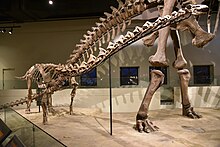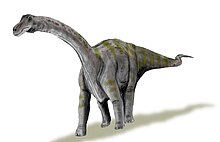拉佩托龙属
| 拉佩托龙属 化石时期:晚白垩世,
| |
|---|---|

| |
| 菲尔德自然史博物馆展出的幼体骨架 | |
| 科学分类 | |
| 界: | 动物界 Animalia |
| 门: | 脊索动物门 Chordata |
| 纲: | 蜥形纲 Sauropsida |
| 总目: | 恐龙总目 Dinosauria |
| 目: | 蜥臀目 Saurischia |
| 亚目: | †蜥脚形亚目 Sauropodomorpha |
| 下目: | †蜥脚下目 Sauropoda |
| 演化支: | †泰坦巨龙类 Titanosauria |
| 演化支: | †岩盔龙类 Lithostrotia |
| 科: | †萨尔塔龙科 Saltasauridae |
| 亚科: | †萨尔塔龙亚科 Saltasaurinae |
| 属: | †拉佩托龙属 Rapetosaurus Curry Rogers & Forster, 2001 |
| 模式种 | |
| †克氏拉佩托龙 Rapetosaurus krausei Curry Rogers & Forster, 2001
| |
拉佩托龙(学名:Rapetosaurus,意为“拉佩托蜥蜴”,过去曾误译为掠食龙)是种泰坦巨龙类的蜥脚类恐龙,生存于晚白垩世的马达加斯加,约7000万年前到6600万年前。克氏拉佩托龙(R. krausei)是模式种兼唯一种。如同其他蜥脚类,拉佩托龙是四足植食性,身长估计15米。
发现
[编辑]克氏拉佩托龙代表着首个发现近乎完整且带有头骨的泰坦巨龙类骨骸,有助于澄清该类群长期以来的分类争议,并提供其他许多破碎泰坦巨龙类的重建参考范本。
2001年克莉丝蒂娜·库里·罗杰斯与凯瑟琳·弗斯特在《自然》发表了拉佩托龙的发现,[1]化石是一个近乎完整的幼年个体及其他三只的部分骨骼。作者描述如下:
- “只有少部分的尾巴骨头遗失了”
- —克莉丝蒂娜·库里·罗杰斯
- “我们往山坡挖掘,我们挖得越多,就挖掘到更多的骨头”
- —克莉丝蒂娜·库里·罗杰斯
挖出内容包括一个部分头骨(正模标本UA 8698)、另个部分头骨、一个仅遗失少数尾椎的幼体骨骸及一个不相关的脊椎。其中幼体不但是泰坦巨龙类中,迄今发现过最完整的,也是唯一一具头部与身体连接的标本。
拉佩托龙出土于马达加斯加西北部的马任加盆地,属于称为梅瓦雷诺层砂岩层的Anembalemba段,年代为晚白垩世马斯特里赫特阶,约7000万年前。这个挖掘活动由纽约州立大学石溪分校的团队,加上当地塔那那利佛大学协助所进行。团队领导者大卫·克劳斯自1993年起就在当地挖掘化石;克劳斯与其团队在当地发现了大量的独特化石,除恐龙还出土了鱼类、青蛙、乌龟、蛇、鳄鱼、鸟类、哺乳类化石。
属名的Rapeto取自马拉加西神话的恶作剧巨人拉佩托,[2]类似北美洲传说中的伐木巨人Paul Bunyan,而sauros则是希腊文中的蜥蜴。种名krausei来自于挖掘团队的领导者戴维·克劳斯。
描述
[编辑]

拉佩托龙是典型的蜥脚类,拥有短而纤细的尾巴、特长颈部、如象般的巨大身躯。头形类似梁龙科,吻部长而狭窄,鼻孔位于头顶。拉佩托龙为植食,其小型铅笔的牙齿适合撕扯枝叶而非咀嚼。
以泰坦巨龙类平均来看,拉佩托龙体型适中。据描述者称,幼体标本从头到尾长约8米,重量可能略同于一只大象。成体身长可能为两倍,约15米,[3]但仍远小于其他同类(如阿根廷龙)。2020年莫里纳培瑞兹和拉腊曼迪根据可能的成体标本股骨MAD 93-18推算身长16.5米及体重10.3吨。[4]
分类
[编辑]
- “最让研究这些动物的古生物学家感到挫折的是,我们并不清楚泰坦巨龙类头颅骨的长相”
- —克莉丝蒂娜·库里·罗杰斯
泰坦巨龙类是蜥脚下目中物种最多的演化支,但化石纪录却普遍稀少。其他蜥脚类演化支,即使是小范围如腕龙科,也都有较完整的发现。在发现拉佩托龙以前,泰坦巨龙类有约30属仅知来自少量部分骨骼、头骨或碎片。这种状况造成演化支内的物种关联、以及其与蜥脚类其他进阶演化支(如大鼻龙类)之间的关系难以确立。泰坦巨龙类成为“无法分类物种集中地”,许多属因缺乏足够资讯而分类未定。
拉佩托龙有着类似梁龙的头骨,证实泰坦巨龙类头骨比过去所认为的更多样化。多数研究人员认为泰坦巨龙类头骨为箱形,鼻孔位于侧边,类似梁龙;此特征使某些具类似梁龙头骨的物种(如耐梅盖特龙)被分到大鼻龙类而非梁龙科。对拉佩托龙头骨与其他身体部分的研究也确认了原先的推测:泰坦巨龙类与腕龙科最为接近。据美国国家科学基金会的Rich Lane所称:“发现这种恐龙特别让人兴奋,因为牠们确认了泰坦巨龙类与腕龙科之间的关系,这关系之前只能依靠推测”。
目前拉佩托龙被归类于岩盔龙类。
古生物学
[编辑]
发育
[编辑]罗杰斯及同事在博物馆藏找到罕见的拉佩托龙幼体标本,估计体重约40公斤,死亡时年纪约39至77天。推测孵化时体重3.4公斤。具研究显示,蜥脚类幼体就算在很少甚至缺乏亲属照顾的情况下,也能够生存下来。对骨骼细部的分析发现,当时马达加斯加严重干旱可能造成年轻拉佩托龙饿死。[5][6]
古生态学
[编辑]马斯特里赫特阶的马达加斯加,跟现代一样是座岛屿,在不到2000万年之前才从印度次大陆分裂开来。马岛持续往北漂移,但当时所处纬度仍比现今偏南10至15度。气候普遍为半干旱,气温和降雨有明显季节变化。许多史前动物栖息于砂质河流所瓜分的沿海泛滥平原。[7]可信度高的地质证据显示,雨季来临前,土石流定期流经这些河道,掩埋之前旱季死亡的动物尸体,提供保存化石的良好条件。[8]当地海平面在整段马斯特里赫特阶都在持续升高,并一直延续到古新世,因此拉佩托龙也可能游走于潮汐海滩环境。邻近地区的贝里沃察层呈现同期的海相环境。[7]
梅瓦雷诺层除了拉佩托龙,还产出鱼类、蛙类、蜥蜴、蛇、[7]七种鳄形超目、[9]五至六种哺乳类(如冈瓦那兽目、非胎盘类真兽下纲,其中前者有大体型的文塔纳兽)、[9]芙萝拿鸟等数种鸟类、[7]可能有飞行能力的奔龙科胁空鸟龙、[10][11]西北阿根廷龙科的恶龙、[12]阿贝力龙科的玛君龙。[13]

1996年发现的玛君龙头骨与印度和阿根廷的近缘物种相似,代表这些冈瓦纳古陆残块间的陆桥在晚白垩世依然存在,远晚于过去所认为。可能的情境是南美和南极间存在陆桥,让动物得以穿越并一路达到印度和马达加斯加。玛君龙是其生态系中最大的掠食者,而唯一已知的共存大型植食恐龙是蜥脚类,包括拉佩托龙,研究认为玛君龙专门掠食牠们,而拉佩托龙骨骼上发现的齿痕证实玛君龙无论是否进行猎杀,都至少曾吃过牠们。[14]
泰坦巨龙类生活情况与其他蜥脚类不同,通常与大型鸟臀目共存,如角龙科、鸭嘴龙科、甲龙科。但拉佩托龙是其中的例外,同栖地的大型植食动物已知只有另一种泰坦巨龙类,小型植食动物也甚为罕见,过去一百年来当地仅发现过狮鼻鳄一种。由于鸟臀目的缺乏,使史前马达加斯加的植食动物生态系呈现与晚白垩世其他地区截然不同的风貌。[1]
参考来源
[编辑]- ^ 1.0 1.1 Curry Rogers, K.; Forster, C.A. The last of the dinosaur titans: a new sauropod from Madagascar. Nature. 2001, 412 (6846): 530–534. Bibcode:2001Natur.412..530C. PMID 11484051. S2CID 4347583. doi:10.1038/35087566.
- ^ Zoë Crossland, Ancestral Encounters in Highland Madagascar: Material Signs and Traces of the Dead, Cambridge University Press, 17/02/2014
- ^ Montague, J.R. Estimates of body size and geological time of origin for 612 dinosaur genera (Saurischia, Ornithischia). Florida Scientist. 2006, 69 (4): 243–257. JSTOR 24321451.
- ^ Molina-Perez & Larramendi. Dinosaur Facts and Figures: The Sauropods and Other Sauropodomorphs. New Jersey: Princeton University Press. 2020: 265.
- ^ Rapetosaurus krausei: Tiny titanosaurus was just a few weeks old, scientists say - Los Angeles Times. Los Angeles Times. [2022-04-07]. (原始内容存档于2022-04-07).
- ^ Lap Dinos? Gigantic Sauropods Started Out Chihuahua-Size | Live Science. Live Science. [2022-04-07]. (原始内容存档于2022-04-07).
- ^ 7.0 7.1 7.2 7.3 Rogers, Raymond R.; Krause, David W.; Curry Rogers, Kristina; Rasoamiaramanana, Armand H.; Rahantarisoa, Lydia. Paleoenvironment and Paleoecology of Majungasaurus crenatissimus (Theropoda: Abelisauridae) from the Late Cretaceous of Madagascar. Sampson, Scott D.; Krause, David W. (编). Majungasaurus crenatissimus (Theropoda: Abelisauridae) from the Late Cretaceous of Madagascar. Society of Vertebrate Paleontology Memoir 8 27. 2007: 21–31. S2CID 130262308. doi:10.1671/0272-4634(2007)27[21:PAPOMC]2.0.CO;2.
- ^ Rogers, Raymond R. Fine-grained debris flows and extraordinary vertebrate burials in the Late Cretaceous of Madagascar 33 (4): 297–300. 2005. Bibcode:2005Geo....33..297R. doi:10.1130/G21036.1.
- ^ 9.0 9.1 Krause, David W.; O'Connor, Patrick M.; Curry Rogers, Kristina; Sampson, Scott D.; Buckley, Gregory A.; Rogers, Raymond R. Late Cretaceous terrestrial vertebrates from Madagascar: implications for Latin American biogeography. Annals of the Missouri Botanical Garden. 2006, 93 (2): 178–208 [2023-04-22]. S2CID 9166607. doi:10.3417/0026-6493(2006)93[178:LCTVFM]2.0.CO;2. (原始内容存档于2016-04-11).
- ^ Forster, Catherine; Sampson, Scott D.; Chiappe, Luis M.; Krause, David W. The theropod ancestry of birds: new evidence from the Late Cretaceous of Madagascar. Science. 1998, 279 (5358): 1915–1919. Bibcode:1998Sci...279.1915F. PMID 9506938. doi:10.1126/science.279.5358.1915.
- ^ Makovicky, Peter J.; Apesteguía, Sebastian; Agnolín, Federico L. The earliest dromaeosaurid theropod from South America. Nature. 2005, 437 (7061): 1007–1011. Bibcode:2005Natur.437.1007M. PMID 16222297. S2CID 27078534. doi:10.1038/nature03996.
- ^ Sampson, Scott D.; Carrano, Matthew T.; Forster, Catherine A. A bizarre predatory dinosaur from the Late Cretaceous of Madagascar. Nature. 2001, 409 (6819): 504–506. Bibcode:2001Natur.409..504S. PMID 11206544. S2CID 205013285. doi:10.1038/35054046.
- ^ Krause, David W.; Sampson, Scott D.; Carrano, Matthew T.; O'Connor, Patrick M. Overview of the history of discovery, taxonomy, phylogeny, and biogeography of Majungasaurus crenatissimus (Theropoda: Abelisauridae) from the Late Cretaceous of Madagascar. Sampson, Scott D.; Krause, David W. (编). Majungasaurus crenatissimus (Theropoda: Abelisauridae) from the Late Cretaceous of Madagascar. Society of Vertebrate Paleontology Memoir 8 27. 2007: 1–20. S2CID 13274054. doi:10.1671/0272-4634(2007)27[1:OOTHOD]2.0.CO;2.
- ^ Rogers, Raymond R.; Krause, David W.; Curry Rogers, Kristina. Cannibalism in the Madagascan dinosaur Majungatholus atopus 422 (6931): 515–518. 2007. Bibcode:2003Natur.422..515R. PMID 12673249. S2CID 4389583. doi:10.1038/nature01532.
- Kristina Curry Rogers, and Catherine A. Forster. 2004. "The skull of Rapetosaurus krausei (Sauropoda: Titanosauria) from the Late Cretaceous of Madagascar". Journal of Vertebrate Paleontology, 24(1), pages 121–144. Abstract at BioOne
外部链接
[编辑]- Paleontology News — Rapetosaurus from the Science Museum of Minnesota.
- Stony Brook Paleontologists Discover New Dinosaur and Name It in Honor of One of Their Own from SUNY-Stony Brook.
- New Dinosaur Species Found from Time for Kids Online.
- Skeleton of New Dinosaur "Titan" Found in Madagascar (页面存档备份,存于互联网档案馆) from National Geographic.
- Dino skull fills knowledge gap (页面存档备份,存于互联网档案馆) from the BBC.
- New Madagascar Dinosaur Discoveries (页面存档备份,存于互联网档案馆) from the T. Rex Museum.
- A press release (页面存档备份,存于互联网档案馆), from the National Science Foundation, including a reconstruction (illustration).
|
Text is available under the CC BY-SA 4.0 license; additional terms may apply.
Images, videos and audio are available under their respective licenses.













